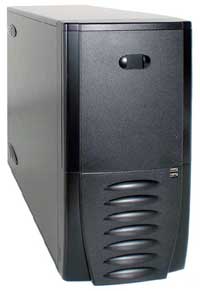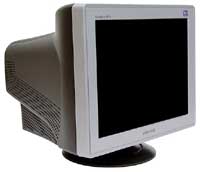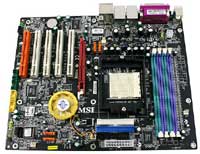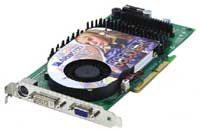AMD Mid-Range Gaming System
If you want some more
oomph in your system - say you like higher resolutions and antialiasing, or maybe you're a competitive online gamer - you could upgrade a few parts in the Budget System and end up with acceptable performance. We're going to kick it up another notch for the Mid-Range segment by improving nearly every component.
| Mid-Range AMD Athlon 64 System |
| Hardware |
Recommended Component |
Price |
| Processor |
AMD Athlon 64 3500+ 512K 2.2 GHz (939) 90nm |
285 |
| Motherboard |
MSI K8N Neo2 Platinum |
131 |
| Memory |
Mushkin Dual Pack 2x512 PC3200 2.5-3-3 |
159 |
| Video Card |
Albatron GeFORCE 6800 GT 256MB GDDR3 |
374 |
| Hard Drive |
Seagate 160GB SATA 7200RPM 8MB Model ST3160023AS |
93 |
| Optical Drive |
NEC DVD+/-RW Drive Model 3500A |
72 |
| Case and Power Supply |
Antec SLK3700-BQE with 350W |
91 |
| Display |
Samsung SyncMaster 997DF 19 CRT |
234 |
| Speakers |
Logitech Z-640 5.1 |
52 |
| Keyboard |
Logitech Internet Keyboard |
17 |
| Mouse |
Microsoft IntelliMouse Optical |
24 |
| Bottom Line |
|
1532 |

Click to enlarge. |
We return to several components that we have recommended in the past for the Mid-Range system. We've doubled the amount of RAM, and we've upgraded the case and PSU to the Antec SLK3700-BQE. It's not a flashy case, so if you're interested in that, you might look elsewhere. Nevertheless, it is a well thought out design, and the use of dual 120mm fans provides ample cooling when you add in the front fan. For the monitor, we have upgraded to a 19" CRT, which has the ability to run at 1600x1200 with a 75 Hz refresh rate. The NEC FE991SB is also an option, although it costs $40 more. We have upgraded to a Serial ATA hard drive with 160GB storage capacity, again staying with Seagate and their five-year warranty. Most of the other base components remain the same, although we opted for the five-button Microsoft IntelliMouse Optical this time.

Click to enlarge. |
The major changes come in the selection of motherboard, CPU, and graphics card. This should come as no surprise, as we have already mentioned several times that these are the most important aspects of a gaming system. For the processor, we have upgraded to an Athlon 64 3500+. The raw clockspeed advantage is not that great, but our
initial tests of the 90nm parts show a slight performance increase relative to the older 130nm 3500+, particularly in games, and it also has better overclocking capabilities if you're interested in that. The power use of the 90 nm parts is also substantially lower than the 130 nm design. The total price increase is $20 relative to the 130nm part, so either one is fine. The motherboard that we have selected uses the NForce3 250 Ultra chipset, and it was also our Gold Editor's Choice in our
Socket 939 Motherboard Roundup. There are several socket 939 motherboards with similar features that use the VIA K8T800 Pro chipset, but we have stuck with the NVIDIA chipset as tests have shown that it has a slight performance advantage when used with an NVIDIA graphics card compared to boards using the VIA chipset. ATI boards do not incur any penalties either, should you choose to go that route. If you prefer the VIA based boards, the Abit AV8 and Asus A8V both received our Silver Editor's Choice.

Click to enlarge. |
Speaking of graphics, our recommendation goes to a GeForce 6800GT AGP model. With 16 pixel pipelines, a 350 MHz GPU core and 1 GHz GDDR3 RAM, it provides nearly twice the performance of the 9800 Pro and significantly more than the 6600GT as well. Performance doesn't vary much if at all between the various manufacturers, so we have selected the card that we could find for the lowest price. You could also look into spending a bit more for a BFG 6800GT OC model that comes factory overclocked or the Leadtek model with it's larger two-slot HSF, but otherwise there is not a whole lot to differentiate among the designs. For ATI lovers, the X800 Pro actually offers very similar performance to the 6800GT. It only has 12 pixel pipelines, but since they're clocked at 475 MHz instead of 350 MHz, it ends up as almost a tie. The 6800GT has faster RAM - 1 GHz compared to 900 MHz - and it also includes Shader Model 3.0 support, not to mention a lower price. If you can find the X800 Pro for less than the 6800GT, though, it's definitely worth considering.

Click to enlarge. |
Then again, the AGP socket could become something of a limitation for upgrades by that time. We have recently previewed the
NForce 4 chipset as well as
ATI's RX480. Both should be available for purchase before the end of the year, and the NVIDIA boards will likely start showing up by the end of this month. If you're considering a socket 939 platform, and assuming you're willing to pay the price premium, it could be worth waiting for the PCI Express motherboards to ship. We'll take a look at PCI Express costs with our Intel Mid-Range alternative. SLI is also a very attractive feature for those looking to buy one card now and upgrade later. All told, an SLI-capable system will probably cost about $100 more than an equivalent AGP setup, but with AGP you're stuck with one graphics card.














70 Comments
View All Comments
blckgrffn - Tuesday, November 23, 2004 - link
At Newegg, sorry.blckgrffn - Tuesday, November 23, 2004 - link
$35 shipped, 420W thermaltake silent purepower w/18A on the +12 rail - can't beat that. No sense in not upgrading to it in my opinion. Also has two SATA power connectors. It may not be the best, but it is a good brand for low dough, and it regularly retails for under $40. I see no reason not to reccommend it as an alternative, at least.Just my $.02 :-)
JarredWalton - Tuesday, November 23, 2004 - link
I was gone for the weekend due to a personal matter, which is why I have not commented much yet. Basically, the budget segment is extremely difficult to target without cutting some corners. The PSU is definitely one of the corners that was cut. I will certainly agree that a cheap PSU is not the best option, but for a moderate system it should do okay. We do not build and test every one of the systems we recommend here, although we do test the majority of the parts. For the budget system, even a moderate PSU is going to add $50 to the price. It might be worth it, but I would go with the generic for a little while if you're on a tight budget.The mid-range use of the SLK3700-BQE case and PSU is a different story. The 350W Antec PSUs are actually quite good and when paired with that setup I have yet to experience any issues. If you're going to add in a second hard drive and optical drive and try overclocking, it could present a problem, but for the stock recommendation it will work.
I thought I made the PSU situation clear in the article, but looking back I guess it was sort of relegated to a few comments made in the high-end and component summary pages. A good PSU is never a bad investment. Trying to convince someone to spend $75 on a name-brand 400W+ PSU instead of upgrading some other component is difficult to do, unfortunately. I'll make sure I don't overlook this in the future - particularly on the mid-range systems.
Gorion: The component summaries were arranged in order of price, with my suggestion of what budget each component falls into. You'll note that many of the parts do not match up directly with the system we put them in, for example we had to use a "mid-range" priced motherboard for the Intel budget setup. The graphics cards in particular are where we "overspent" - which makes sense for gaming.
You're right on the mouse: the MX510 is the wired version. My bad. Basically, get what mouse you like. I have tried the MX510 before, and while not bad, it's a personal taste. I like the 4th and 5th buttons on opposite sides like the "cheap" MS mice. For precision, Logitech may be better, but I am definitely not hardcore enough to be able to tell the difference between mouse precision on these models. :)
Glassmaster - Tuesday, November 23, 2004 - link
#45: I'm not suggesting that a PSU recommendation should account for overclocking, however, on AMD's offical forums, where I help with Athlon 64 troubleshooting, insufficant PSUs are the most common problem. People are having problems with their PSUs handling stock specifications when they do something demanding, like play a modern game. This is a gaming guide after all...That's why I ask if you build and stress test these systems with the latest games before making a recommendation. If you do, and you find that a particular cheap generic PSU (with less than the consensus recommendation of 18-20A on the 12V rail) works well, that would be good to know. However that has not been my experience.
I wouldn't bother to post at all if I didn't respect this site a lot and enjoy reading it--I would just stop visiting.
Glassmaster.
Wesley Fink - Tuesday, November 23, 2004 - link
RE: The Epox budget board. Jarred had originally selected the Epox budget nf3-250Gb for his budget AMD gamer, but I shared many of the emails I had received re: memory problems with that board. Nothing major, but memory compatibility issues and 4-dimm 333 downclocks not seen with the Chaintech board. While we all agree the Epox has a bit better feature set the Chaintech is known to be rock solid and friendly to just about any memory you feed it. That is the reason for the Chaintech choice for Budget. If you know your memory choice works well with the Epox then by all means choose that board.As an overclocker I have learned the hard way how very important the PS is for Athlon 64 and Socket T Intel. However, most gamers are NOT overclockers - they may overclock the video card but they rarely do much with system overclocking. Given that, Jarred's PS choices make more sense, though I do agree budget Power Supplies are the weakest links in most systems. I'm sure those gamers that "system-overclock" will throw some rocks here, and there are exceptions to every generalization.
thegreatbernie - Tuesday, November 23, 2004 - link
I haven't been able to find the Albatron GeFORCE 6800 GT 256MB GDDR3 for $374. Newegg has it for $455.Gioron - Tuesday, November 23, 2004 - link
Jarred:Two nit-picks, the first being the motherboard chart on the component summary page. The third motherboard down threw me for a second, until I realized it was the third budget motherboard, not the mid-range motherboard it was listed as.
Second, the MX510 is a wired mouse, not wireless. The wireless Ligitech mice are the MX700 and MX1000, the MX510, MX500, and MX300 are all wired mice. I'm guessing you're thinking about the MX700 mouse, which I admit is a bit of an acquired taste, but if you haven't used one before, I'd highly recommend trying out the MX510 before dismissing it.
Disclaimer: I personally use an MX1000 as a replacement to my MX700, but I freely admit its not for everyone.
SDA - Tuesday, November 23, 2004 - link
Damn, I hate to double-post, but I just found something interesting while poking around:http://forums.anandtech.com/messageview.aspx?catid...
Might be worth a read for those of you that don't understand what I have against low-quality power supplies.
SDA - Tuesday, November 23, 2004 - link
#38, no, I guess it doesn't :( No offense to AT, but I doubt they bother-- after all, the PSU is such a trivial piece of hardware, isn't it? Sigh.. anyway, correct me if I'm wrong, but it'd seem that the PSU in the Athenatech case is an L&C unit. Deer/L&C units aren't exactly.. known for their quality.Now, I don't want to seem like I'm sniping, because overall I think this is a pretty good guide. Everyone's going to have their own suggestions and their own favorite parts. A quality PSU isn't something that one would pick just because of their preference, though, it's something one would pick because of their sanity. I've lost count of the number of malfunctioning systems I've seen fixed with replacement PSUs, not to mention how many cheapo power supplies I've seen fail in amusing ways before their time.. picking a cheap PSU to power a solid system is a newbie mistake, it's a shame to see a pro make it.
bofkentucky - Tuesday, November 23, 2004 - link
#39Except it is overpriced, uses an overpriced processor, uses slow ram and is feature limited (No on board SATA). Dothan has potential, but wait until the 915 based dothan boards hit the streets, then you will see a real performance option.